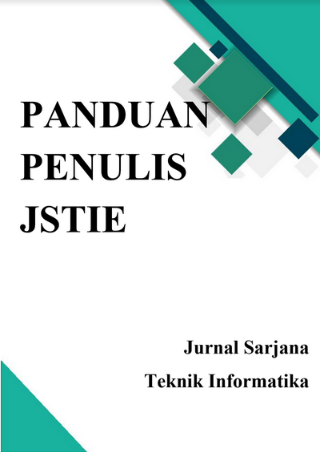APLIKASI PENGENALAN HURUF HANGEUL BERBASIS MULTIMEDIA INTERAKTIF
DOI:
https://doi.org/10.12928/jstie.v1i1.2550Abstract
Saat ini semakin banyak orang yang menaruh minat untuk mempelajari bahasa asing selain bahasa Inggris, salah satunya adalah Bahasa Korea. Saat melakukan penelitian di lembaga kursus Bahasa Korea siswa masih kesulitan dalam penulisan dan pengucapan huruf Hangeul dengan benar. Dapat dicontohkan kesulitan tersebut adalah ketika menulis sebuah kata, siswa masih sulit dalam meletakkan huruf akhir yang tepat untuk kata tersebut.
Subjek dalam penelitian ini adalah aplikasi multimedia sebagai media pengenalan huruf Hangeul. Pengumpulan data dalam penelitian ini menggunakan metode kepustakaan, metode observasi, dan metode wawancara. Aplikasi disusun dengan prosedur yang mencakup indentifikasi masalah, studi kelayakan, analisis kebutuhan sistem, merancang konsep, merancang isi, merancang naskah, merancang grafik, memproduksi sistem, pengetesan sistem dengan black box dan alpha test, penggunaan sistem dan tahap akhir adalah memelihara sistem.
Hasil penelitian ini adalah aplikasi multimedia sebagai media pembelajaran Bahasa Korea Dasar tentang pengenalan huruf Hangeul khususnya cara penuliasan dan cara pengucapan bagi siswa kursus Bahasa Korea kelas dasar. Aplikasi telah diuji coba menggunakan black box test dan alpha test. Berdasarkan hasil uji coba tersebut dapat disimpulkan bahwa aplikasi ini dapat membantu proses pembelajaran secara mandiri pada siswa dan dapat digunakan sebagai alat bantu guru yang dapat menunjang pembelajaran Bahasa Korea di kelas.
Kata Kunci : Bahasa Korea, Huruf Hangeul, Multimedia
References
Balqis, Zahrani, S.S., 2012, “Bahasa Korea Super Mudahâ€. Familia Publisher, Yogyakarta.
Kindred, A.R., 2000, “Itroduction To Computersâ€, Prentise Hall 2nd Edition, Sydney.
Rosenberg, R.S, 1986, “Computer And The Information Societyâ€, New York, Chicester, Brisbane, Toronto, Singapure, Dalhouse University
Santoso, I., 1997, “Interaksi Manusia Dan Komputer Teori Dan Praktekâ€, Andi Publisher, Yogyakarta.
Setiawati, Nur. (2010). “Pembelajaran Bahasa Jepang Dasar Berbasis Multimediaâ€. Universitas Ahmad Dahlan, Yogyakarta.
Suyanto, M., 2003, “Multimedia Alat untuk Meningkatkan Keunggulan Bersaingâ€, Andi Publisher, Yogyakarta.
Suyanto, M, 2004, “Analisis dan desain aplikasi multimedia untuk pemasaranâ€. Andi Publisher, Yogyakarta.Andi Publisher, Yogyakarta.
Tridalestari, Arik, Ferra. (2011). “Aplikasi Transliterator dan Translator Bahasa Indonesia ke Bahasa Korea dan Bahasa Korea ke Bahasa Indonesiaâ€, Universitas Ahmad Dahlan, Yogyakarta.
Tiara (2010). “Bahasa Korea 2â€. SMAN7-KOICA.
http://anggriawan.web.id/2011/01/belajar-tulisan-korea-hangul.html (diakses tanggal 28 Desember 2011 jam 15.00)
http://bnp2tki.go.id/statistik-mainmenu-86/statistik-mainmenu-205/1064-paparan-publik-capaian-kinerja-tahun 2008.html (diakses tanggal 20 Juli 2011 jam 18.00)
http://bisnis.vivanews.com/news/read/220146-korea-buka-10-000lowongan-kerja (diakses tanggal 20 Juli 2011 jam 09.00)
Downloads
Published
Issue
Section
License
License and Copyright Agreement
In submitting the manuscript to the journal, the authors certify that:
- They are authorized by their co-authors to enter into these arrangements.
- The work described has not been formally published before, except in the form of an abstract or as part of a published lecture, review, thesis, or overlay journal. Please also carefully read Journal Posting Your Article Policy.
- The work is not under consideration for publication elsewhere.
- The work has been approved by all the author(s) and by the responsible authorities – tacitly or explicitly – of the institutes where the work has been carried out.
- They secure the right to reproduce any material that has already been published or copyrighted elsewhere.
- They agree to the following license and copyright agreement.
Copyright
Authors who publish with Jurnal Sarjana Teknik Informatika agree to the following terms:
- Authors retain copyright and grant the journal right of first publication with the work simultaneously licensed under a Creative Commons Attribution License (CC BY-SA 4.0) that allows others to share the work with an acknowledgement of the work's authorship and initial publication in this journal.
- Authors are able to enter into separate, additional contractual arrangements for the non-exclusive distribution of the journal's published version of the work (e.g., post it to an institutional repository or publish it in a book), with an acknowledgement of its initial publication in this journal.
- Authors are permitted and encouraged to post their work online (e.g., in institutional repositories or on their website) prior to and during the submission process, as it can lead to productive exchanges, as well as earlier and greater citation of published work.







